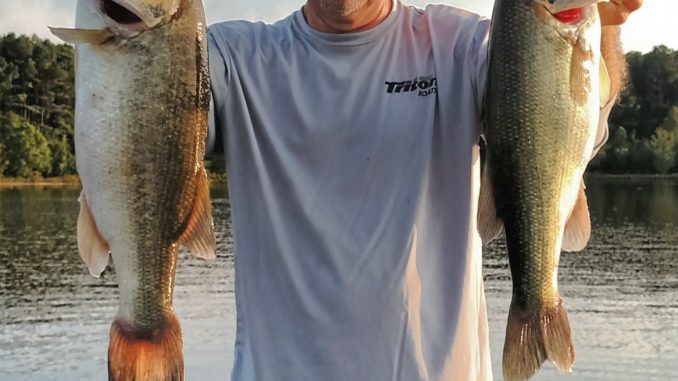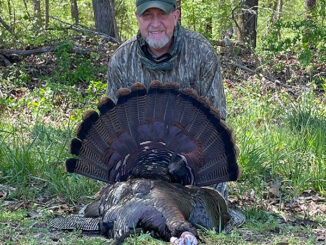
Plenty of bass will be staging and biting this month at Falls of Neuse Lake when all the planets align. Learn how to get the most from one of North Carolina’s top fisheries.
Around the Raleigh-Durham area, some disagreements exist among anglers about which of three local lakes — Shearon Harris, Jordan or Falls of the Neuse — offers the fishing for largemouth bass.
For tournament bass fishermen, the answer has been clear the past several years. For numbers of fish and the probability of landing a lunker, Falls of the Neuse draws the highest approval rate.
A 16- to 20-inch slot limit on Harris, which has been managed for trophy fish for years, keeps most tournament anglers away, plus, the lake barely covers more than 4,000 acres and receives tremendous fishing pressure.
Falls of Neuse, which covers 12,410 acres, shows up almost as great in N.C. Wildlife Resources Commission sampling as Harris, and it has no special limits; a five-fish, 14-inch minimum creel limit applies, with anglers allowed to keep two small fish per day.
“Falls has a lot of big fish, and so does Harris,” said K.C. Choosakul of Sanford, who owns KC’s Marine Service & Performance in Cameron.
Choosakul, 47, said he’d choose Falls of Neuse over Harris.
“If they changed the (slot) at Harris Lake, you’d see 28- to 30-pound stringers like do at Falls now,” he said.
Last spring, Choosakul said, Falls was “on fire.
“And I think Harris has fallen behind it a little. I think people are taking the big fish out of Harris because of the slot limit.”
Todd Massey, 51, of Chapel Hill, agrees with Choosakul; Falls might have a slight edge over other Triangle lakes when it comes to producing quality bass.
“My best bass weighed 9 pounds, 15 ounces; I caught it in March 2014 at Falls,” he said. “I’ve caught three fish that weighed more than 9 pounds, and all of them came from Falls.”
Massey said he’ll begin targeting bass in March in the upper end of Falls Lake, specifically the area between the mouth of Ledge Creek and Rollingview Marina north to the I-85 bridge.
“The middle section is east of (Ledge Creek) point to the NC 50 bridge,” he said. “The river section includes east of the NC 50 bridge to Barton Creek access in Wake County. The lower section is east of Barton Creek to the dam.”
Massey doesn’t fish upstream of the I-85 bridge in March because bass are just beginning to transition from deep water. In that area, huge, shallow-water flats cover hundreds of acres, easy places to get stuck or run up on stumps. A safe but narrow channel winds through the flats to the mouth of the Eno River; the flats fill up with bass once the spawn kicks in late in April and in early May.
“In March, I like to fish the middle section and kind of follow where the channel swings near the banks and out of the creeks,” Massey said.
In the middle section, he targets the outside edges of water willow grass.”
“Fifty degrees is the magic mark,” he said. “When the water temperature rises from 50 to 58 degrees, bass start to stage (on) outside wood in pretty shallow water on either side of creek channels. They’ll sit in front of spawning flats, on inside corners of shoreline pockets and the outside edges of willow weed.”
Before the water reaches the 50-degree mark, Massey casts a black-and-blue jig at woody structure he targets in 2 to 4 feet of water. Using his trolling motor, he cruises and casts to brush, stickups, laydown trees, willow bushes and stumps.
“What I throw always depends on water temperature and clarity,” he said. “Once the water temperature gets higher than 52 degrees, I’ll mix in a spinnerbait and target the same areas. Once the temperature gets above 55 or 56 degrees, I’ll start fishing with a bladed jig and a little shallow-running crankbait.”
Bladed jigs, aka “Chatterbaits” are often referred to as perfect choices for prespawn bass, especially those staging adjacent to spawning flats. In dingy water, the norm on Falls in the spring, dark colors — black/blue, Candy Craw or California Craw — are effective.
“I’ll switch to a shad pattern if the water is clear,” Massey said. “If it’s stained, which is usually the case, I’ll throw black-and-blue or green pumpkin.”
When he finds bass staging on flats, he also may throw a jerkbait or Alabama rig.
Massey prefers a 7-foot Cashion baitcasting rod matched with a Lew’s SSG1H reels with a 6.8:1 retrieve ratio spooled with 15- to 20-pound fluorocarbon. He’ll move up to a 7-foot-10 or 8-foot flipping stick and heavy line if necessary.
Choosakul and his tournament partner, Tim Penhollow of Oxford, did plenty of damage last season on the Piedmont Bass Classics circuit, winning two events on Falls of Neuse.
“I like fishing in March because you can usually find warm pockets, and they’ll hold bass,” he said. “You have to run up and down a lake and look for the best staging spots with the warmest water.
“At Falls, if the water fluctuates and gets in the bushes, that’s where you fish in March. But if the water’s not high, bass stage at flats. Falls has this fine grass (water willow), and if you can find where it’s attached to the bottom, the biggest bass will hang out in that stuff.”
Choosakul mostly uses a 7-foot Cashion rod mated to a Shimano Chronarch C14 baitcasting reel with a 7:1 gear ratio, spooled with 20-pound Trilene fluorocarbon XL — unless he bulks up to a flipping stick and jig.
“I like to fish a jig real slow in the willow grass or work a Chatterbait through it,” he said. “You can’t see (the grass) because it’s too shallow, and you can’t get a boat in there. If you find a patch, just back off and fish on top of it. The big females use it as cover.
“When they hit, it won’t feel like a bite. It feels like you’ve hit a snag. Then the lure will start moving. That’s when you know one has picked it up.”
Weather is the key to fishing at Falls during March, he said.
“Three or four days with warm weather that moves the water temperature into the 50s, bass will try to move (shallow),” Choosakul said. “If you get one warm day, they won’t go back in the pockets, but they’ll stage at secondary points and creek channels. Buck bass will stay, but the big females drop into the ditches.”
In a normal March — with one or two warm days per week — Choosakul will fish a shallow-running crankbait.
“If the water gets high, I’ll throw a Chatterbait in the (willow) bushes. But I throw what the weather conditions tell me to throw. We do our best when we can use shallow-running crankbaits,” said Choosakul, who loves the end of the month. “The temperature you want to see is 58 to 60 degrees. You can fish everywhere — shallow or deep. They’re on the prowl, looking for something to eat.”
DESTINATION INFORMATION
HOW TO GET THERE — Falls Lake is north of Durham and west of Raleigh. I-85, US 50 and NC 98 offer good access to public boat landings. Eno River, Ledge Rock, Hickory Hill and Upper Barton Creek are popular, convenient ramps. Visit www.ncpaws.com for exact locations.
WHEN TO GO — Falls is one of the first lakes in North Carolina where bass-fishing really cranks up, often in late February, but certainly in March. Some truly huge fish have been caught over the years during the first weekend in March.
BEST TECHNIQUES — Anglers use small crankbaits, swimbaits, Chatterbaits and jig-n-pig. Baitcasting tackle is preferred because of heavy cover around the lake. Spool up with 10- to 20-pound line, 30 if you’re flipping heavy cover.
FISHING INFO/GUIDES — Jeffrey Thomas, Carolina Outdoors, 919-770-4654; Jamie Olive, Haulin’ Bass Guide Service, 919-625-0707; Rollingview Marina, 919-596-2194. See also Guides and Charters in Classifieds.
ACCOMMODATIONS — WoodSpring Suites, Raleigh Northeast/Wake Forest, 919-322-1550; Candlewood Suites, Raleigh/Wake Forest, 919-554-6901; Best Western Butner/Creedmoor, 919-575-5942. For camping, N.C. Division of Parks and Recreation, Falls Lake, 919-733-4181.
MAPS — Fishing Hot Spots, 800-255-6277, www.fishinghotspots.com.




